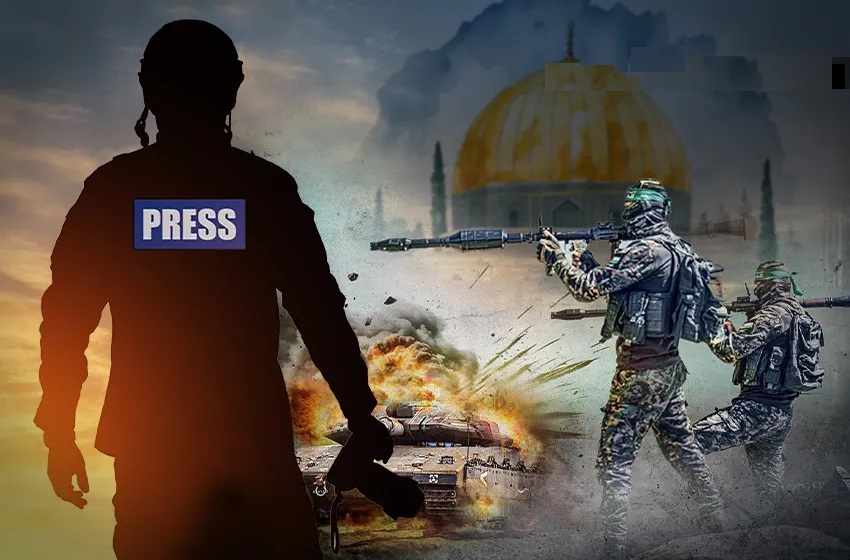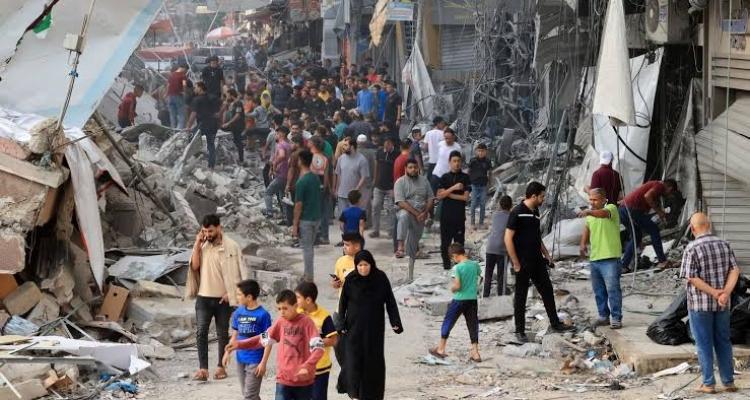
SANA'A May 21. 2024 (Saba) - The world is witnessing the largest war of deception and falsification in contemporary history regarding the ongoing aggression against the Gaza Strip since the seventh of last October, and the massacres, genocide, and systematic starvation policy, with the influence, polarization, and manipulation of public opinion by the traditional Western media and social media. It is a war that “did not "No one would expect its size."
The Western media, especially the American ones, departed from the traditions of professionalism, media neutrality, and credibility that they had praised for years, and adopted the Zionist narrative. These media outlets deliberately adopted fake news and misinformation campaigns in shaping accounts and narratives about the events of the war and the tragedies resulting from it, in addition to manipulating the impressions of the followers. And their emotions.
Western media outlets have been subjected to a barrage of criticism due to their unilateral and biased coverage of the Zionist enemy in its ongoing aggression against Gaza, which has caused the spread of misleading information. This constitutes a fundamental challenge today to confront this fierce media campaign targeting the Arab and Islamic nation with the advancement of artificial intelligence software.
We have witnessed misinformation campaigns targeting journalists, conflicting media narratives, censorship, fake news, media disinformation, and the mobilization of public opinion through social media.
Many seminars touched on the role of digital media in covering the ongoing aggressive war on the Gaza Strip and issues of social justice and human rights. The history of the Palestinian people has always been one of the basic topics and the discrepancy in media coverage between social media and traditional media.
However, many critics revealed that many social media influencers outside Palestine used their platforms to shed light on what is happening there, and this raw content attracted millions of views and contributed to spreading awareness about the tragic conditions under which Palestinians are suffering.
Not to mention the coverage carried out by reporters from inside Gaza itself via social media, which helped “humanize” the Palestinians in the eyes of the outside viewer and lead to the major shift in the global narrative thanks to publishing via social media, despite the unilateral coverage and censorship practiced by social media. Western media.
Critics raised the issue of framing the war on Gaza and media coverage narratives because they are an important tool used to direct public opinion. Information can be controlled through the deliberate use of specific words or refraining from using some words in order to market a specific narrative, and the broad and deliberate efforts made by the Western media supporting the Zionist entity to... Shedding light on the events of October 7 and separating the “Al-Aqsa Flood” operation from its historical context.
This blindness to historical context and the misinformation practiced by traditional media has reached political decision-making circles, where the context is often ignored since it does not align with the political goals of “American and Zionist” politicians.
However, thanks to growing transparent coverage by regional media and independent reporters on the ground in Gaza, people are beginning to question Western media bias more and turn to local sources.
Critics pointed out the difference between misinformation and false information, and how information is used as a weapon within the framework of global media coverage of the war on Gaza.
Critics explained that “misinformation” means unintentionally spreading incorrect news, while “false information” means intentionally spreading false news with the aim of causing harm.
Critics said: Some parties may resort to tactics of spreading false information in order to legitimize the atrocities they practice and mobilize public opinion in their favor... recalling the historical example of the fake news that the Americans broadcast during the war on Iraq in order to justify their illegal war, and likening it to efforts To justify the attack on the Gaza Strip.
In general, state-sponsored dissemination of fake news is used as a means to dehumanize Palestinians and to influence global public opinion of Zionist military actions.
Critics stressed the global importance of social media and youth engagement, calling for the creation of a Palestinian lobby to pressure decision-makers in Washington.
Critics criticized the process of normalizing some Arab countries' relations with the Zionist enemy entity, despite popular Arab support for the Palestinians, which remains solid.
Critics believed that although public opinion in many Western countries supports a ceasefire, we still lack the political will to work on a workable solution.
The Zionist aggression against Gaza is witnessing the most prominent and most recent manifestation, and the broader investment in artificial intelligence technologies in social media, and the attempt to influence public opinion. This reality now puts the world face to face with the realization of the most prominent fears that have long surrounded the use of artificial intelligence, in terms of its ability to falsify reality.
And even the extent of the strength of persuasion that it may have, and consequently the extent of its influence, which has recently reached a stage that has made those working in the field of verifying information and combating misleading news in a state of helplessness and confusion, in keeping up with the misuse of artificial intelligence in misleading.
Over the course of two months of aggression, hundreds of fake pictures, stories, news, and information invaded social networking sites, and gained global spread linked to the widespread follow-up of the course of events that began on the seventh of last October. It was something expected, for information auditors, who were accustomed to the increasing level of fake news and misinformation campaigns in the country. Times of crises and wars.
The most prominent forms of forgery were photos and videos, some of which people believed to a great extent, while in others the manipulation was clear and people were not widely misled.
Experts confirmed that chatbots may “share conspiracy theories in a more credible and convincing way, by reducing structural errors or mistranslations,” noting that there are “no tactics available to effectively monitor them.”
They explained that “there is no clear mechanism that would eliminate the threats created” by generative artificial intelligence robots.
The Western media, especially the American ones, departed from the traditions of professionalism, media neutrality, and credibility that they had praised for years, and adopted the Zionist narrative. These media outlets deliberately adopted fake news and misinformation campaigns in shaping accounts and narratives about the events of the war and the tragedies resulting from it, in addition to manipulating the impressions of the followers. And their emotions.
Western media outlets have been subjected to a barrage of criticism due to their unilateral and biased coverage of the Zionist enemy in its ongoing aggression against Gaza, which has caused the spread of misleading information. This constitutes a fundamental challenge today to confront this fierce media campaign targeting the Arab and Islamic nation with the advancement of artificial intelligence software.
We have witnessed misinformation campaigns targeting journalists, conflicting media narratives, censorship, fake news, media disinformation, and the mobilization of public opinion through social media.
Many seminars touched on the role of digital media in covering the ongoing aggressive war on the Gaza Strip and issues of social justice and human rights. The history of the Palestinian people has always been one of the basic topics and the discrepancy in media coverage between social media and traditional media.
However, many critics revealed that many social media influencers outside Palestine used their platforms to shed light on what is happening there, and this raw content attracted millions of views and contributed to spreading awareness about the tragic conditions under which Palestinians are suffering.
Not to mention the coverage carried out by reporters from inside Gaza itself via social media, which helped “humanize” the Palestinians in the eyes of the outside viewer and lead to the major shift in the global narrative thanks to publishing via social media, despite the unilateral coverage and censorship practiced by social media. Western media.
Critics raised the issue of framing the war on Gaza and media coverage narratives because they are an important tool used to direct public opinion. Information can be controlled through the deliberate use of specific words or refraining from using some words in order to market a specific narrative, and the broad and deliberate efforts made by the Western media supporting the Zionist entity to... Shedding light on the events of October 7 and separating the “Al-Aqsa Flood” operation from its historical context.
This blindness to historical context and the misinformation practiced by traditional media has reached political decision-making circles, where the context is often ignored since it does not align with the political goals of “American and Zionist” politicians.
However, thanks to growing transparent coverage by regional media and independent reporters on the ground in Gaza, people are beginning to question Western media bias more and turn to local sources.
Critics pointed out the difference between misinformation and false information, and how information is used as a weapon within the framework of global media coverage of the war on Gaza.
Critics explained that “misinformation” means unintentionally spreading incorrect news, while “false information” means intentionally spreading false news with the aim of causing harm.
Critics said: Some parties may resort to tactics of spreading false information in order to legitimize the atrocities they practice and mobilize public opinion in their favor... recalling the historical example of the fake news that the Americans broadcast during the war on Iraq in order to justify their illegal war, and likening it to efforts To justify the attack on the Gaza Strip.
In general, state-sponsored dissemination of fake news is used as a means to dehumanize Palestinians and to influence global public opinion of Zionist military actions.
Critics stressed the global importance of social media and youth engagement, calling for the creation of a Palestinian lobby to pressure decision-makers in Washington.
Critics criticized the process of normalizing some Arab countries' relations with the Zionist enemy entity, despite popular Arab support for the Palestinians, which remains solid.
Critics believed that although public opinion in many Western countries supports a ceasefire, we still lack the political will to work on a workable solution.
The Zionist aggression against Gaza is witnessing the most prominent and most recent manifestation, and the broader investment in artificial intelligence technologies in social media, and the attempt to influence public opinion. This reality now puts the world face to face with the realization of the most prominent fears that have long surrounded the use of artificial intelligence, in terms of its ability to falsify reality.
And even the extent of the strength of persuasion that it may have, and consequently the extent of its influence, which has recently reached a stage that has made those working in the field of verifying information and combating misleading news in a state of helplessness and confusion, in keeping up with the misuse of artificial intelligence in misleading.
Over the course of two months of aggression, hundreds of fake pictures, stories, news, and information invaded social networking sites, and gained global spread linked to the widespread follow-up of the course of events that began on the seventh of last October. It was something expected, for information auditors, who were accustomed to the increasing level of fake news and misinformation campaigns in the country. Times of crises and wars.
The most prominent forms of forgery were photos and videos, some of which people believed to a great extent, while in others the manipulation was clear and people were not widely misled.
Experts confirmed that chatbots may “share conspiracy theories in a more credible and convincing way, by reducing structural errors or mistranslations,” noting that there are “no tactics available to effectively monitor them.”
They explained that “there is no clear mechanism that would eliminate the threats created” by generative artificial intelligence robots.
resource : Saba
